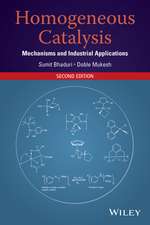Chiral Sulfur Ligands: Asymmetric Catalysis: RSC Catalysis, cartea 2
Autor Helene Pellissier, Hul Ne Pellissier Editat de Jerry J. Spiveyen Limba Engleză Hardback – 30 sep 2009
The goal of this book is to show the high potential of chiral sulfur-containing ligands to promote numerous asymmetric catalytic transformations. The important number of reports appeared in the literature over the last 35 years often highlighted spectacular results in terms of efficiency and enantioselectivity, allowing access to many biologically important molecules, which clearly demonstrates that these ligands can now be recognised as real competitors to the more usual phosphorus- or nitrogen-containing ligands. A key point of reference for post-graduate students, researchers and academics.
Din seria RSC Catalysis
- 14%
 Preț: 941.61 lei
Preț: 941.61 lei - 9%
 Preț: 1109.78 lei
Preț: 1109.78 lei - 14%
 Preț: 1369.88 lei
Preț: 1369.88 lei - 14%
 Preț: 1363.60 lei
Preț: 1363.60 lei - 14%
 Preț: 1120.35 lei
Preț: 1120.35 lei - 14%
 Preț: 1119.00 lei
Preț: 1119.00 lei - 14%
 Preț: 1347.55 lei
Preț: 1347.55 lei - 14%
 Preț: 1381.56 lei
Preț: 1381.56 lei - 14%
 Preț: 1248.32 lei
Preț: 1248.32 lei - 14%
 Preț: 1244.21 lei
Preț: 1244.21 lei - 14%
 Preț: 1081.57 lei
Preț: 1081.57 lei - 14%
 Preț: 1369.04 lei
Preț: 1369.04 lei - 14%
 Preț: 1378.97 lei
Preț: 1378.97 lei - 14%
 Preț: 1393.17 lei
Preț: 1393.17 lei - 14%
 Preț: 1547.47 lei
Preț: 1547.47 lei - 14%
 Preț: 775.38 lei
Preț: 775.38 lei - 14%
 Preț: 1132.10 lei
Preț: 1132.10 lei - 14%
 Preț: 946.72 lei
Preț: 946.72 lei - 14%
 Preț: 948.21 lei
Preț: 948.21 lei - 14%
 Preț: 958.32 lei
Preț: 958.32 lei - 14%
 Preț: 1389.84 lei
Preț: 1389.84 lei - 14%
 Preț: 951.54 lei
Preț: 951.54 lei - 14%
 Preț: 955.98 lei
Preț: 955.98 lei - 14%
 Preț: 1309.36 lei
Preț: 1309.36 lei - 9%
 Preț: 1004.61 lei
Preț: 1004.61 lei
Preț: 1088.21 lei
Preț vechi: 1265.36 lei
-14% Nou
Puncte Express: 1632
Preț estimativ în valută:
208.23€ • 217.96$ • 173.31£
208.23€ • 217.96$ • 173.31£
Carte tipărită la comandă
Livrare economică 31 martie-14 aprilie
Preluare comenzi: 021 569.72.76
Specificații
ISBN-13: 9781847559241
ISBN-10: 1847559247
Pagini: 402
Ilustrații: 1
Dimensiuni: 155 x 236 x 25 mm
Greutate: 0.73 kg
Editura: Royal Society Of Chemistry
Seriile RSC Catalysis Series, RSC Catalysis
Locul publicării:United Kingdom
ISBN-10: 1847559247
Pagini: 402
Ilustrații: 1
Dimensiuni: 155 x 236 x 25 mm
Greutate: 0.73 kg
Editura: Royal Society Of Chemistry
Seriile RSC Catalysis Series, RSC Catalysis
Locul publicării:United Kingdom
Cuprins
Chapter 1: Allylic Substitution; Chapter 2: Conjugate Addition; Chapter 3: Addition of Organometallic Reagents to Aldehydes; Chapter 4: Addition of Organozinc Reagents to Ketones; Chapter 5: Diels-Alder Reaction; Chapter 6: Cyclopropanation; Chapter 7: Heck-Type Reactions; Chapter 8: Hydrogenation; Chapter 9: Hydrogen Transfer; Chapter 10: Miscellaneous Reactions; Subject Index
Textul de pe ultima copertă
The preparation of chiral compounds is an important and challenging area of contemporary synthetic organic chemistry, mainly in connection with the fact that most natural products are chiral and their physiological or pharmacological properties depend upon their recognition by chiral receptors, which will interact only with molecules of the proper absolute configuration. The use of chiral drugs in enantiopure form is now a standard requirement for virtually every new chemical entity, and the development of new synthetic methods to obtain enantiopure compounds has become a key goal for pharmaceutical companies. The impressive number of reports dealing with the use of chiral sulfur-containing ligands for asymmetric catalysis is well representative of the success of such ligands to promote numerous catalytic transformations. Chiral sulfur-containing ligands represent a highly efficient class of ligands applicable in a broad variety of reaction types, also in view of some peculiar properties, which differentiate them from more popular ligands such as phosphorus- or nitrogen-containing ligands. Whereas the synthesis of chiral phosphorus ligands is often complex and difficult, the preparation of chiral sulfur compounds is much more convenient. Consequently, a wide diversity of chiral sulfur-containing ligands, more than forty different classes, is easily available either directly from the chiral pool or by facile modifications of other heteroatomic ligands. Many of the sulfur-containing ligands have only recently appeared in the literature, and it is clear that their application in asymmetric catalysis will undoubtedly increase in the near future for a number of additional asymmetric reactions, due in part to their easy synthesis. Moreover, due to their great stability, asymmetric heterogeneous catalysis seems to be a good way to develop the potential of these ligands in an economic and environmentally friendly manner. The goal of this book is to provide to researchers and professionals of academic and industrial laboratories with a broad overview of the works concerning the use of chiral sulfur-containing ligands in one of the most important focal areas in organic synthesis, asymmetric catalysis. The book is divided into ten chapters corresponding to the different types of reactions based on the use of complexes containing chiral sulfur ligands, such as:- * allylic substitution * conjugate addition * addition of organometallic reagents to aldehydes * addition of organozinc reagents to ketones * Diels?Alder reaction * cyclopropanation * Heck-type reactions * hydrogenation * hydrogen transfer * miscellaneous reactions
Notă biografică
Helene Pellissier was born in Gap, France. She carried out her PhD under the supervision of Dr G. Gil in Marseille and then entered the Centre National de la Recherche Scientifique in 1988. After a postdoctoral position in Professor K. P. C. Vollhardt's group at Berkeley, she joined the group of Professor M. Santelli in Marseille in 1992. Here she focused on the chemistry of BISTRO and its large application in organic synthesis.
Descriere
The goal of this book is to show the high potential of chiral sulfur-containing ligands to promote numerous asymmetric catalytic transformations. These ligands can now be recognised as real competitors to the more usual phosphorus- or nitrogen-containing ligands.




